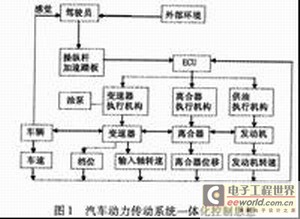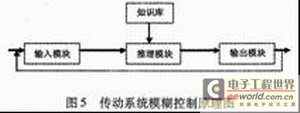Research on Integrated Intelligent Control Technology of Automotive Power Transmission System
With the development of science and technology, people are increasingly demanding cars. In order to pursue the economy, power, safety and comfort of automobiles, countries around the world continue to use advanced technology and develop advanced devices to make some performances of automobiles more unprecedented. In the mid-1980s, the timely application of traditional control made the performance of the automobile system machine assembly greatly improved, but it also exposed some shortcomings. The emergence and development of artificial intelligence has promoted the development of traditional control to intelligent control. Since the early 1990s, many experts and scholars have begun to pay attention to the application of intelligent control technology in the automotive field. Currently, the most widely used intelligent control mainly includes fuzzy control and neural network control.
1 The concept of integrated intelligent control of automotive powertrain
1.1 Integrated control thinking

Integrated control of automotive powertrain system refers to the application of electronic technology and automatic shifting theory. The electronic control unit (ECU) is the core, and the hydraulic actuator is used to control the separation and engagement of the clutch, select the shifting operation, and control the engine through the electronic device. The oil supply realizes the automatic operation of starting and shifting. The basic control idea is: according to the driver's intention (accelerator pedal, brake pedal, joystick, etc.) and the state of the vehicle (engine speed, input shaft speed, vehicle speed, gear position), according to the appropriate control law (change Gear schedule, clutch engagement law, etc., with the corresponding actuator (clutch actuator, shift selector actuator) and electronic device (engine fueling control electronics) to the vehicle's powertrain (engine, clutch, transmission) Perform joint operations. As shown in Figure 1.
1.2 Integrated control method
The integrated control method of power transmission system is generally divided into three categories:
(1) Two-machine or multi-machine communication. Information sharing is achieved between the engine ECU and the transmission ECU. This control method makes full use of the mature engine and transmission control technology. It has fewer changes to the original system, is easy to implement, and has lower development cost. However, due to more wiring, the integration is not high.
(2) The overall control of the engine and transmission is achieved by a single ECU. The advantages are high integration, reduced peripheral wiring, and improved reliability, but high requirements for ECUs and high development costs. The power control system on the Toyota Lexus Ls400 sedan, the four-speed automatic transmission A341 E with intelligent control system and the engine use the same ECU, the microcomputer-equipped ECU controls the shifting of the automatic transmission, the lock timing, and the actuator in the planetary gear system. The oil pressure (clutch, brake) and engine torque during shifting optimize the shift quality.
(3) The overall control is carried out using the CAN bus structure. At present, more CAN bus is used in the car, and the structure of connecting the two control subsystems of the engine and the transmission through the CAN bus is shown in Fig. 2. Through the CAN bus, not only can the command, request and some basic states of the car (such as engine speed, vehicle speed, cooling water temperature, etc.) be transmitted between the two systems, but also some real-time data such as oil quantity and speed signal can be transmitted. Wait for a higher priority.
2 The basic components of the integrated control system for automotive powertrain
The function of the control system is to automatically adjust the transmission ratio and working state of the basic transmission components according to the driver's intention and the change of the driving environment of the vehicle, so as to achieve the best efficiency of the transmission system and the overall performance of the vehicle. In general, the vehicle control system is mainly composed of three parts: the vehicle data acquisition system (sensor part), the electronic control unit and the actuator.

(1) The composition of the vehicle data acquisition system (sensor section).
In the entire control system, part of the function of the sensor is equal to the visual, audible and tactile system of the driver in the case of manually operating the shifting vehicle, and the parameter signals required for the various shifts are collected and transmitted to the electronic control unit.
The vehicle travels and works according to the driver's intention, and the vehicle control system must be able to correctly identify and implement the driver's manipulation. The driver's intent is identified by sensors that test changes in vehicle control mechanisms (eg, accelerator pedals, brake pedals, steering wheel angles, etc.) and are analyzed.
The sensors used in automobiles are mainly the following: magnetoelectric sensors, magnetoresistive sensors, photoelectric sensors, Hall sensors, thermal sensors, rheostat sensors, piezoelectric crystal sensors, and the like. The sensors used in the transmission part of the powertrain system mainly include: an engine speed sensor, a vehicle speed sensor, a throttle opening degree sensor, a clutch displacement sensor, and the like. Among them, the engine speed sensor and the vehicle speed sensor use a magnetoelectric sensor and a Hall sensor, etc., which use a magnetoelectric signal principle, and the throttle opening sensor and the clutch displacement sensor each use a variable resistance sensor.
In addition to the sensor, other signals are signaled through switches and controllers or other means. Commonly used switches include multi-function switches, forced low-range switches, and the like. Switches are also important signal input methods.
(2) Electronic control unit.
The Electronic Control Unit (ECU) is the heart of the entire control system. Its function is to detect and provide signals according to the driver's intention and the vehicle's motion state parameters, and perform gear shifting or working state change. The main functions of the electronic control unit are: signal acquisition and preprocessing, driver control intent recognition, vehicle status recognition, shift decision (shifting law), shift quality control, fault diagnosis function, output and display. A typical electronic control unit is shown in Figure 3.

The new generation of controllers is comprehensive in function and control performance. It uses a high-performance 16-bit or 32-bit microprocessor, and some even use a custom microprocessor that includes most of the functions required for control, simplifying The control circuit also enhances the functionality and reliability of the circuit. For example, Japan's JATC Q products use NEC and Motorola 16-bit and 32-bit microprocessors; Germany's ZF developed a 5-speed automatic transmission, the SHP19's shift controller, using Motorola's 32-bit POWERPC microprocessor. Due to the controller's microprocessor update, the shift control is more complicated, and the input and output functions are more powerful due to the peripheral circuit expansion of the processor. In order to achieve greater control performance, not only the control program but also the embedded real-time operating system is used in these controllers.
(3) Executing agency.
After the sampling system obtains the input signal, the control system sends it to the controller for data processing. After the data processing is finished, the control signal of the electronic control unit will realize the change of the working state of the power transmission system through the actuator to ensure the performance of the vehicle. control. At the same time, the actuator guarantees the control of the shift quality. Actuators that implement gear shifting typically use solenoid valves.
3 Intelligent control technology and its application in power transmission system
3.1 Intelligent Control Technology
The generation of intelligent control comes from the high complexity, uncertainty of the controlled system and the increasing demand for control performance. Such controlled systems are difficult to describe with precise mathematical models (differential equations and difference equations). Compared with traditional control, fuzzy control, which is one of the intelligent control methods, has three advantages: it can simulate human fuzzy reasoning and decision-making process from behavior; it can achieve better control without establishing mathematical model; Linear control tasks, while conventional controllers often have difficulty controlling requirements for nonlinear characteristics.
As the frontier of automatic control technology, intelligent control technology is based on intelligent control theory, computer technology, artificial intelligence and operations research. It is applicable to unknown or uncertain factors of controlled objects and environments, difficult to establish mathematical models, operating environment and working conditions. Occasional changes occur. A good intelligent control system should be able to meet the requirements of multi-objective and multi-performance indicators. It can use knowledge to reason and learn. It can adapt to changes in object characteristics and operating conditions. It has good robustness, adaptability, fault tolerance and real-time. Sex and diversity.
3.2 Application of Intelligent Control Technology in Automotive Power Transmission System
A car is a complex multi-degree-of-freedom system. Under the influence of external uncertainties, its dynamic characteristics will change greatly or even be unstable. Many experts are looking for an effective way to control the dynamic characteristics of a car to meet its requirements. Because the performance of intelligent control is superior to traditional control, it is widely used in the automotive field.
At present, intelligent control technology has penetrated into all aspects of the car, such as the car's motion control, driver model, tire model and brake system, suspension system, steering system, transmission system and engine control.
3.2.1 Engine control
Engine technology determines and influences the development of basic vehicle technology. Due to fierce market competition and the development and implementation of new fuel emission standards, engine technology has shifted from simply pursuing power and reliability to pursuing good fuel economy and reducing emissions. Engine control includes: fuel injection control, ignition timing control, knock control, idle speed control, exhaust gas recirculation control, and air-fuel ratio closed-loop control.
In the early 1990s, Fiat successfully achieved fuzzy control of engine idle speed. Subsequently, Mitsubishi was not far behind and proposed related plans. In the mid-1990s, MarTInez and Jamshidi applied fuzzy control to the engine to control the engine idle speed and air-fuel ratio. The structural principle is shown in Figure 4.

The fuzzy controller inputs the error of the speed and the acceleration, and obtains a suitable throttle opening value u by the fuzzy operation. Soon, Ma-jors and others successfully used neural network theory to achieve control of the fuel-air ratio of the engine.
3.2.2 Transmission system control
In the early 1990s, Ford and HTC had conducted a lot of research on the application of neural networks and fuzzy logic systems in the dynamic characteristics and control of automobiles. Nissan was the first to use fuzzy controllers to control the shifting laws and anti-locking of the automotive transmission system. Pressure modulator for the brake system. In the mid-1990s, Sakai et al. considered the driving conditions of the car up and down, and developed a variable-speed fuzzy controller. The principle is shown in Figure 5. The fuzzy controller takes the vehicle speed, acceleration, throttle opening, road resistance, braking time and current shifting condition as input, and obtains a suitable shift value after the fuzzy operation.

4 Conclusion
The automotive power transmission integrated control system is the product of the integrated control of the power transmission system using high-performance microcontrollers. With the development of automotive electronic technology and the improvement of living standards, people's requirements for vehicle performance are also getting higher and higher. The overall control of automotive power transmission system by means of microcontroller has become a technology developed at home and abroad. At the same time, intelligent control technology is increasingly widely used in the field of automotive control, making intelligent control technology become one of the important development directions of overall vehicle control.
Specialed in developing and manufacturing in all kins of mobile phone chargers around 15 years with our own brand MLF, also with much OEM/ODM experience and including help our customer to do customized plastic housing mold . Our factory can output 300K pcs high quality USB 2.0 Mobile Phone Charger daily
Mobile Phone Charger
Mobile Phone Charger,Fast Phone Charger,Cell Phone Charger,Dual Usb Charger
Meile Group Limited , http://www.hkmeile.com